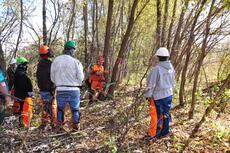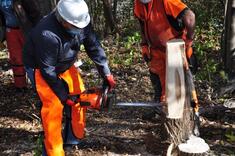This year, we are providing free and unlimited access to the OSHA 29 CFR 1904 Recording and Reporting Occupational Injuries and Illnesses webinar. You may view that webinar at https://www.youtube.com/watch?v=Zh-M4wKq7UA . Please contact Margret Meade at 515.210.6617 or at [email protected] with any recordkeeping questions that you may have.
|
It’s that time of year again! Time to review, and correct if necessary, your OSHA 300 log entries and post the completed and certified 300A form. Make sure that each 300 log entry has a corresponding 301 form that has the required information entered.
This year, we are providing free and unlimited access to the OSHA 29 CFR 1904 Recording and Reporting Occupational Injuries and Illnesses webinar. You may view that webinar at https://www.youtube.com/watch?v=Zh-M4wKq7UA . Please contact Margret Meade at 515.210.6617 or at [email protected] with any recordkeeping questions that you may have.
0 Comments
To find continuing education opportunities, please view the “Training Calendar” at programs.iowadnr.gov/opcertweb/ Training events where Iowa DNR staff will make presentations are listed below. See the listing on the appropriate date on the Training Calendar for registration instructions. Look at the calendar often, as there are new opportunities posted throughout the week.
Even with all of the electronic communication options out there these days, email can be as effective as ever, as long as you follow best practices.
Thanks to the fact that email has been around for more than two decades now, researchers have had plenty of time to study how people use and respond to email and have identify certain factors that influence its success (success meaning that people open the emails and do with it what the sender intended). Here are some considerations that many communication experts accept as best practices. Subject Lines
Content
Deadline for Mortgage, Rent and Utility Assistance: December 4th
Governor Reynolds announced an additional allocation of CARES Act funds to support Iowa renters and homeowners at-risk of eviction or foreclosure due to a COVID-19-related loss of income. The Iowa Eviction and Foreclosure Prevention program has now been allocated a total of $37.4 million, with approximately $8 million remaining available. The deadline to apply for rent and mortgage assistance as well as utility assistance through the Iowa Residential Utility Disruption Prevention program is Dec. 4, 2020. “At no fault of their own, many Iowans are struggling to pay their bills as a result of lost income due to the COVID-19 pandemic,” said Gov. Reynolds. “Today’s announcement bolsters the Iowa Eviction and Foreclosure Prevention program, which is helping Iowa homeowners and renters make their rent or mortgage payments. Our team will continue to assist Iowans in accessing this critical assistance as the Dec. 4th deadline approaches.” “Nearly 11,000 renters and 500 homeowners have received assistance with their rent or mortgage payments and another 2,800 have applied for utility assistance to date,” said IEDA and IFA Executive Director Debi Durham. “Our goal is to assist as many Iowans that have been impacted by COVID-19 and are at-risk of eviction, foreclosure or utility disruption as possible.” The programs are funded through federal CARES Act funds, which requires that all funds be expended by Dec. 30, 2020. To be eligible for either program:
Communications Corner: Repurpose content to make it go further – and make it more effective11/18/2020 You want your customers to read, understand, and put into action the information that you provide them. If you only put out the message once, though, the likelihood that many people will see it – let alone read it and do something with it – may be wishful thinking.
To better guarantee that your communications are effective, put them out there again and again – in different ways and in different places. How does this work? Take one 150- to 200-word article on any given topic.
If you use one article in these five ways, your chances of reaching more of your customers, and making the message stick with them, are much greater. You may want to try this strategy with national observances and important seasonal topics (e.g., using space heaters or carbon monoxide issues). Iowa households experiencing a loss of income related to COVID-19 may be eligible for utility debt relief under the Iowa Residential Utility Disruption Prevention Program. The program, funded by the federal CARES Act, was announced October 9, 2020, by Gov. Kim Reynolds and the Iowa Economic Development Authority and provides eligible households up to $2,000 toward unpaid electric, natural gas, and water bills between March 17 and October 31, 2020.
The deadline to apply has been extended to Friday, December 4, 2020, at 11:59 p.m. Payments through the program will be made directly to utility providers and applied to the approved applicant's account. Learn more about the available assistance, eligibility guidelines, how to apply, and required documentation, along with program frequently asked questions. IAMU welcomed a new staff member on November 16, Sandra Jordan, (Sandy), is a Safety Professional with over 15 years of experience in construction and manufacturing. She grew up in Iowa and attended the University of Iowa, graduating with a BA in English accompanied by a Teaching Certification for secondary education. She also attended Kirkwood Community College in their Agricultural department, and then earned her COSS (Certified Occupational Safety Specialist) through the same educational institution. She is currently working on her MBA, which will have a concentration in Human Resources when she finishes in 2021. Sandra is also an Outreach Trainer for OSHA in Construction, facilitating both 10 & 30 hour courses. She holds extensive experience in writing and implementing safety programs, classroom and hands-on safety training, performing on-site risk assessments and behavioral safety audits, as well as safety data and accident investigation/root cause analysis in her passionate endeavor to reduce accidents and injuries for Iowa’s workers. Sandy met her husband at 13 years of age and they have been married for almost 35 years. They have no children of their own, but love and spoil 3 large dogs and “about” 6 cats! Sandy is committed to the safety profession and to excellent customer service. The excitement of being part of creating successful safety cultures and beginning a new chapter in her career is evident in her positive attitude.
Last month Nathan Stanford, an Instructor with Forest Safety Instruction in Wisconsin, taught a day-long chainsaw safety class for the Safety Specialists and Regional Coordinators. Part of the day was spent outside with Nathan teaching the basics of cutting techniques, planning the cut, assessing where and how the tree will fall, cutting through knots or with limbs under pressure and what to do if the tree starts to fall the wrong way.
The Iowa Department of Public Health has released a summary of the enhanced public health measures effective Wednesday, Nov. 11 at 12:01 a.m. until Monday, Nov. 30 at 11:59 p.m.
Gathering Restrictions: Social, community, recreational, or leisure
Youth and High School Sports:
Restaurants and Bars: Restaurant or bar, including a wedding reception venue, winery, brewery, distillery, country club, or other social or fraternal club
Personal Service Establishments: Salons, barbershops, massage therapy establishments, tattoo establishments, and tanning facilities
Closer/Prolonged Contact Establishments: Bowling alleys, pool halls, bingo halls, arcades, indoor playgrounds, children’s play centers
Remote Working/Other Employer Measures: All employers shall evaluate whether any more of their employees can feasibly work remotely and to the extent reasonable, shall take steps to enable such employees to work from home. Those remaining open shall take other reasonable precautions. Download a copy of the enhanced public health measures here. Companies have business plans. Sports teams have game plans. Military divisions have battle plans. Having a plan is crucial for success, yet many utilities lack communication plans.
A communication plan can guide you through your efforts – making sure you cover needed messages in ways that will be most effective without anything being overlooked or forgotten about. Consider developing a plan for an entire year. By taking time to create a guiding document for 2021 now, you may save yourself time, energy, and stress throughout the next year. At a minimum, your yearly communication plan should include:
With a plan, you can work well in advance of when you will deliver your messages so they are well thought out and thorough instead of thrown together at the last minute. |
Archives
July 2024
|





 RSS Feed
RSS Feed
